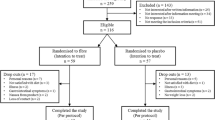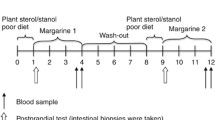Abstract
Background
As the physiological functions of soluble dietary fibre, the favourable efficacy, such as attenuating the absorption of saccharides or lipids, is expected. Resistant maltodextrin, a soluble dietary fibre, was investigated and found that it delays the glucose absorption and attenuates the postprandial rise in the blood glucose levels, however, the efficacy of resistant maltodextrin on lipid metabolism is not yet reported.
Aim of the study
We conducted an animal experiment and a human experiment to investigate the effect of resistant maltodextrin on postprandial blood triacylglycerol elevation.
Methods
1. Rats were fed corn oil with or without resistant maltodextrin and the postprandial changes in triacylglycerol were examined. 2. We then conducted a dietary loading experiment on 13 healthy adult male and female subjects using a meal containing approximately 50 g fat. A beverage not containing resistant maltodextrin was used as a placebo; subjects consumed the loading meal and a beverage containing either 5 g or 10 g resistant maltodextrin; blood was periodically collected to see the changes in serum constituents.
Results
1. The corn oil administration experiment using rats showed that resistant maltodextrin dose-dependently suppressed elevation of blood triacylglycerol levels after corn oil administration. 2. The dietary loading experiment on 13 healthy subjects with 5 or 10 g of resistant maltodextrin showed that; in each administration group, resistant maltodextrin significantly suppressed postprandial elevation of blood triacylglycerol, RLP-cholesterol and insulin.
Conclusion
These results indicate that resistant maltodextrin ingested with fatty meals suppresses the postprandial elevation of blood triacylglycerol levels.



Similar content being viewed by others
References
Carlson LA, Bottiber LE, Ahfeldt PE (1979) Risk factors for myocardial infarction in the Stockholm prospective study. A 14-year follow-up focusing on the role of plasma triglycerides and cholesterol. Acta Med Scand 206:351–360
Carlson LA, Bottiger LE (1985) Risk factors for ischaemic heart disease in men and women. Results of the 19-year follow-up of the Stockholm Prospective Study. Acta Med Scand 218:207–211
Gannon MC, Nuttall FQ, Westphal SA, Seaquist ER (1993) The effect of fat and carbohydrate on plasma glucose, insulin, C-peptide, and triglycerides in normal male subjects. J Am Coll Nutr 12:36–41
Hara Y, Moriguchi S, Kusumoto A, Nakai M, Ono Y, Abe K, Ohta H, Shibata H, Kiso Y, Egawa K (2004) Suppressive effect of oolong tea polymerized polyphenols-enriched oolon tea on postprandial serum triglyceride elevation. Jpn Pharmacol Ther 32:335–342
Inagaki H, Fujita H, Arakawa K, Sugiyama K, Hashizume S, Okuda H (2002) Suppressive effect of tea beverage including globin digest on postprandial serum triglyceride elevation. J Nutr Food 5:131–144
Iso H, Naito Y, Sato S, Kitamura A, Okamura T, Sankai T, Shimamoto T, Iida M, Komachi Y (2001) Serum triglycerides and risk of coronary heat disease among Japanese men and women. Am J Epidemiol 53:490–499
Jenkins DJ, Wolever TM, Leeds AR, Gassull MA, Haisman P, Diliwari J, Goff DV, Metz GL, Alberti KG (1978) Dietary fibres, fibre analogues, and glucose tolerance: importance of viscosity. Br Med J 1:1392–1394
Kane JP, Chen GC, Hamilton RL, Hardman DA, Malloy MJ, Havel RJ (1983) Remnants of lipoproteins of intestinal and hepatic origin in familial dysbetalipoproteinemia. Arteriosclerosis 3:47–56
Karpe F (1999) Postprandial lipoprotein metabolism and atherosclerosis. J Intern Med 246:341–355
Kondo S, Xiao J-Z, Takahashi N, Miyaji K, Iwatsuki K, Kokubo S (2004) Suppressive effects of dietary fiber in yogurt on the postprandial serum lipid levels in healthy adult male volunteers. Biosci Biotechnol Biochem 68:1135–1138
Maddock J (2004) The relationship between obesity and the prevalence of fast food restaurants: state-level analysis. Am J Health Promot 19(2):137–143
Nakajima K, Saito T, Tamura A, Suzuki M, Nakano T, Adachi M, Tanaka A, Tada N, Nakamura H, Campos E (1993) Cholesterol in remnant lipoproteins in human serum using monoclonal anti apo B-100 and A-I immunoaffinity mixed gels. Clin Chim Acta 223:53–71
Nikkila M, Solakivi T, Koivula T, Laippala P, Astrom B (1994) Postprandial plasma lipoprotein changes in relation to apolipoprotein E phenotypes and low density lipoprotein size in men with and without coronary artery disease. Atherosclerosis 106:149–157
Ohkuma K, Matsuda I, Katta Y, Hanno Y (1990) Pyrolysis of starch and its digestibility by enzymes-Characterization of indigestible dextrin-. Denpun Kagaku 37:107–114
Patsch JR, Miesenbock G, Hopferwieser T, Muhlberger V, Knapp E, Dunn JK, Gotto AM Jr, Patsch W (1992) Relation of triglyceride metabolism and coronary artery disease. Studies in the postprandial state. Arterioscler Thromb 12:1336–1345
Teramoto T (2002) Hyperlipidemia - pathophysiology, management and therapy. Nankodo, Tokyo, pp 76–77
Tokunaga K, Matsuoka A (1999) Effects of a FOSHU (food for specifed health use) containing indigestible dextrin as functional component on glucose and fat metabolisms. J Jpn Diab Soc 42:61–65
Tomono S, Kawazu S, Kato N, Ono T, Ishii C, Ito Y, Shimizu M, Shimoyama M, Nakano T, Nakajima K (1994) Uptake of remnant like particles (RLP) in diabetic patients from mouse peritoneal macrophages. J Atheroscler Thromb 1:98–102
Unno T, Suzuki Y, Nozawa A, Sagesaka Y, Kakuda T, Egawa K, Kondo K (2005) Suppressive effect of tea catechins on elevation of postprandial serum triglycerides. Jpn J Nutr Assess 22:207–212
Urata T, Sakurabayashi I, Kawai T (1979) Fractional determination method of lipoprotein - lipid by electrophoresis. Rinsho Kensa 23:871–880
Wakabayashi S (1993) The effects of Indigestible dextrin on sugar tolerance: III. Improvement in sugar torelance by indigestible dextrin on the impaired glucose tolerance model. Folia Endocrinol 69:594–608
Yuasa N, Yasue M, Ikeda M, Shinoda Y, Sato K, Kondo A (2004) The effects of tea beverage containing indigestible dextrin on postprandial blood glucose level after single intake and the safety in continuous intakes. J Jpn Council Adv Food Ingr Res 7:83–93
Author information
Authors and Affiliations
Corresponding author
Rights and permissions
About this article
Cite this article
Kishimoto, Y., Oga, H., Tagami, H. et al. Suppressive effect of resistant maltodextrin on postprandial blood triacylglycerol elevation. Eur J Nutr 46, 133–138 (2007). https://doi.org/10.1007/s00394-007-0643-1
Received:
Accepted:
Published:
Issue Date:
DOI: https://doi.org/10.1007/s00394-007-0643-1




